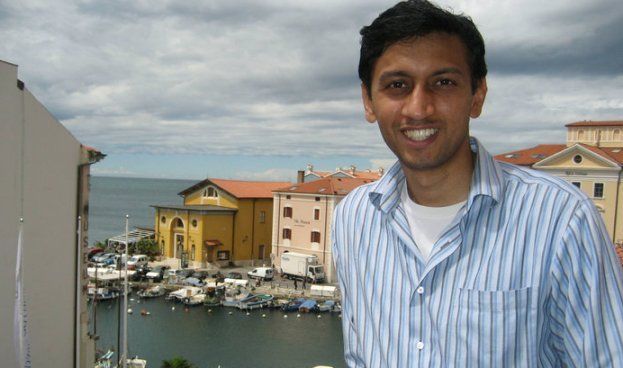“eCommerce Is Only For Long Term Players,” Wharton Professor, Kartik Hosanagar
The eCommerce debate continues to rage in India. For every Flipkart and Myntra, there are companies like TimTara which shake consumer and investor confidence. Is this for real? Is this a bubble? Will we make it? Will we not? Many of these questions are continuously playing on everybody’s mind. A few days back we caught up with a senior advisor at a top ranking investment fund and most of the discussion revolved around the same subject.
Over the course of time that I have been writing on startups, I am not entirely convinced about the skepticism surrounding the eCommerce space. For industries to build, and sectors to mature takes a lot of time. There are many macro and micro factors that play a part. And the enablers for the space are as varied as the post office to the Ministry of IT and Communications. Therefore for the wheel to move and accumulate enough speed a lot of factors have to fall in place, and my sense as an observer is – patience is short among startups and investors.

YourStory recently caught up with Kartik Hosanagar, a tenured Associate Professor of Internet Commerce at The Wharton School of the University of Pennsylvania. Kartik’s expertise lies in new age tools in the social media space and the internet. He has helped a number of new age start ups across the globe, including Socio Square in India – where is also is an investor. Kartik is also the co-founder of New York based Yodle, an internet marketing and advertising company. Kartik has also been involved with brands like Citibank, Amex, Nokia. He is one of the youngest professors to be tenured at Wharton. He graduated as a valedictorian from Birla Institute of Technology and Sciences (BITS, Pilani), India with a Bachelors degree in Electronics and a Masters in Information Systems, and has an MPhil in Management Science and a PhD in Management Science and Information Systems from Carnegie Mellon University.
The expert view
Kartik heads the entrepreneurial cell at Wharton, which is a kind of incubator within Wharton. Talking about the program Kartik says, “Over the course of a year about 30-40 student initiatives are taken and these students are provided training and mentorship. They get to meet alumni who are current entrepreneurs or investors. We help them with investments, building network, office space, conference room and any other resource they may need.” Kartik’s venture, Yodle has come out of the incubator and there are other successful startups as well he says.
Kartik’s stint with internet commerce began in 1999, when he enrolled for his PhD program at Carnegie. “That was the start of it, there was a lot of hype around it and lot of money was poured into it and then the bubble burst. But I continued to be committed to it, because the fundamentals were strong,” says Kartik. His faith in the space stems from the fact that there was an excess of investments to applications. There was lot of investment in application, but the infrastructure was missing. “You need to get more people familiar with the internet first and then with internet commerce. So what happened initially was, you didn’t even have a dialup connection and you want people to buy products from you. That is kind of hard,” explains Kartik.
India today is on a similar curve, internet penetration in our country is only limited to 111 million of the 1 billion plus population, of which emailing and social networking rule the roost. Many brands in the country are tapping into social networks to reach potential consumers, but the fact remains that social networks still act as a platform to meet new people, share pictures and to some extent social gaming. There are still no compelling reasons to buy a product from either social networks or any other online stores. Product touch and feel, bargain hunting, ability to look at more variety are some of the reasons why brick-and-mortar stores still dominate our country’s landscape.
Why the eCommerce bubble burst in US?
Kartik says the 2000 wave was a blessing in disguise for the US market. “A lot of good happened in the process, people setup infrastructure, more people started getting familiar and using the internet.” This ground work in turn helped the next wave in 2003, where the foundation had been laid, new ventures then rode this wave and benefitted. “The models that failed in 2000 are the same ones that worked in 2005. Yodle is an example of that. Investors told us about their past experience and how it had not worked. But we were convinced that 2000 was too early and the model would work and 2005 turned out to be the right time, because by then the fundamentals were in place after the first wave,” explains Kartik.
“Everyone saw the promise of internet and knew it will be big and they were correct. What they were wrong about, was how fast it will happen and when it will happen, that was the problem. If those people had waited they would have seen the benefit. Many companies tried to go public, there were no revenues, but the feeling was we will get there eventually. So many investors were investing because they thought the next quarter there would be revenues and after that there will be profits, but that was not the case. And when it didn’t happen, they suddenly started selling all their holdings and that is when things went out of control,” explains Kartik.
The time taken to get return on investments was longer, and people started believing critics who were labeling the phenomenon to be a flash-in-the-pan activity. “There was no recession in the economy, infact it was the other way round, there was a mini recession caused because of this,” says Kartik.
The India Story
The scene in India today is very similar to the US of 2000, the only difference being we are riding both the first wave and second wave simultaneously. So on one hand we see the infrastructure being setup – internet penetration, logistics, payment gateway, brand building, customer engagement, marketing and on the other hand we are attempting to change consumer behavior.
“India has some advantage because you are coming in late, so you can leap frog a little bit and learn from the West. Another similarity is, there are too many people jumping in and you worry if there is a bit of eCommerce bubble that is happening. Are investors ready to stay for a long term or are they again expecting returns within a year or two. Those kinds of things will always be very difficult to match,” says Kartik. India is also localizing to a great extent, so if Flipkart started cash-on-delivery, Yebhi.com now allows customers to try different products in the comfort of their home, before making a purchase decision.
We ask Kartik to make some predictions about the eCommerce in India and he says there are lot of good things happening for the ecosystem, despite cases like Timtara. “People out there to make quick money will mostly hurt themselves, but they will help the ecosystem a lot. I think one of two things will happen. There will be few big successes – Amazon, came during the first wave, did well and survived, Ebay was from the first wave and survived. So there will be a few companies who will survive and do well and will benefit from the things that the first wave has brought. Many investments will fail, that will be individual investors, but it will help the ecosystem a lot. Because those investments will be for educating larger masses, and making them comfortable to buy online. Whether they get returns from the investment, we will have to wait and see, but they will help the ecosystem a lot. If one investor doesn’t continue, someone else will come in and help continue the process,” explains Kartik.
Online media and marketing
We quizzed Kartik about his investment in Socio Square, and the mobile and internet advertising space is another one he is very bullish about. “Brands are still mostly relying on Google for advertising, but as a platform even Facebook can be make a difference,” he says. Socio Square is focused on ROI-led advertising and mostly uses the platform to help brands engage organically with customers. Kartik speaks about a campaign they did for animated movie Delhi Safari, where they created a maze game using characters from the movie. The game was shared and played by over 100,000 people and people got introduced to the movie characters in very cost effective way. “A ‘Like’ has much more currency than a normal ad. Because once a person has liked you on FB he will always receive any updates that you make on his page. You don’t need to take his permission again and again,” explains Kartik.











